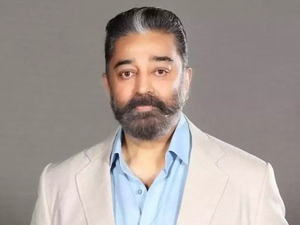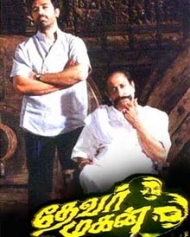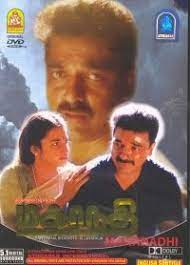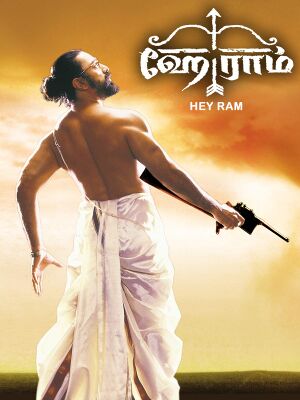Kamal Haasan
இந்தப் பக்கத்தை தமிழில் வாசிக்க: கமல்ஹாசன்
Kamal Haasan (7th November 1954) is a Tamil Film Actor, Screenwriter and one of the Pioneers of the unique literary form of Tamil Screenplay. He has also written poems.
Birth, Education
Kamal Haasan was born on 7th November 1954 in Paramakudi, Ramanathapuram to D. Srinivasa Iyengar, a lawyer and Congress Political Activist, and Rajalakshmi. He was given three names according to the custom of Vaishnava families. His name Kamal Haasan is one of them. Kamal Haasan's elder brother Charu Haasan is a lawyer and a National Award-winning actor. Another brother Chandra Haasan was a lawyer and he also acted in some films. Kamal Haasan's sister Nalini is a Bharatanatyam artist and teaches Bharatham.
Kamal Haasan received his primary education in Paramakudi and later completed his schooling at Muttaiah Chettiar Boys High School and Hindu Higher Secondary School, Chennai when his family moved to Chennai. Unlike his brothers, he dropped out of school at a young age and became active in the film industry.
Personal Life
Kamal Haasan married dancer Vani Ganapathy in 1978 at the age of 24. After divorcing Vani Ganapathi, he was living with actress Sarika. He got married to Sarika after the birth of two daughters, Shruti and Akshara. Sarika later divorced Kamal. Both of his daughters are film actors.
Theater Career
Kamal Haasan participated as a young actor in T.K.S. Nataka Sabha conducted by T.K. Shanmugam. He was involved in all aspects of theater production.
Movie Career
Kamal Haasan made his debut as a child actor in the 1960 film Kalathur Kannamma for which he won the National Award. Kamal Haasan's first Malayalam film Kannum Karalum released in 1962.
Kamal Haasan has been involved in the film industry for sixty two years as a dancer, singer, director, lyricist and actor.
Politics
Kamal Haasan has been presenting his political stances from the beginning. He was parallelly attracted to both Gandhi and E.V. Ramasamy. He cites Gandhi as his predecessors in National Vision, Natural Development, Decentralization, Democratic Populism and E.V. Ramasamy Periyar in Social Justice, Rationalism and Politics isolated from Religion. On 21 February 2018, he started a political party called Makkal Needhi Maiam.
Journalism
Kamal Haasan started a magazine called Maiam for fans, 12 issues were published in 1987 and 9 issues in 1989. Even though it was a magazine for fans, it featured short stories by writers like Ashokamithran, T. Janakiraman, Aadhavan, K.N. Subramaniam, Sujatha, Balakumaran. Contents such as World Cinema Introductions, Cinema Taste, and Kamal Haasan's views on social issues were included. Poet Puviarasu contributed in deciding the content of this magazine.
Awards
Kamal Haasan won the National Award three times for his film acting. He was awarded Padma Shri in 1990 and Padma Bhushan in 2014. He has received several awards including the Chevalier Award from French Government, the Figy Award and three national awards.
Literary Works
Kamal Haasan has written rhythmic poems (Santha Nayam). A serialised story written by Kamal Haasan in 1984 titled Thayam in the magazine Idhayam Pesugirathu was later made into a film titled Aalavanthan.
Screenplays
Kamal Haasan's place in Tamil literature is shaped by his screenplays. Kamal Haasan was in in touch with modern literature and had active conversations with literati from his youth. His large literary circle includes Sujatha, Balakumaran, Gnanakoothan, Puviarasu, Ra.Ki. Rengarajan, Tho. Paramsivan. He was also in conversations with Jayakanthan. He has also written poems with good rhythmic sense (Santha Nayam).
Kamal Haasan was part of the early alternative cinema ventures in Tamil and Malayalam. In 1981 Kamal Haasan - Charu Haasan production Rajaparvai was the first film in which Kamal Haasan contributed directly to the screenplay. He also contributed to the screenplay of Apurva Sagotharargal (1989).
Michael Madana Kamarajan (1990) was announced as Kamal Haasan's screenplay debut. Devar Magan (1992) was Kamal Haasan's first fully produced film with story and screenplay written by him. Directed by Bharathan, the film is considered by critics to be one of the best Tamil films. Mahanadhi (1994) is another important film from Kamal Haasan's story-screenplay (assisted by Ra.Ki. Rangarajan). The film Hey Ram (2000), is considered to be Kamal Haasan's first directorial venture. Anbe Shivam written by Kamal Haasan was released in 2003. In 2004, Virumandi, in 2008, Dasavatharam, in 2013, Vishwaroopam, and in 2015, Utthama Villan were screenplays by Kamal Haasan.
Literary Significance
Kamal Haasan's screenplays are written for mainstream movies. Within that boundary, they have a pioneering importance and a literary place because they are able to create micro domains related to Tamil life and set them completely in the visual language meant for films. Among his screenplays, Devar Magan, Mahanadi, Hey Ram and Anbe Shivam, all four have best qualities attributed to literary masterpieces. Screenplays such as Virumandi, Dasavatharam, Vishwaroopam and Utthama Villan also have places akin to the best works of modern Tamil literature.
Considering that in Tamil screenplays are thought of as language centric, Kamal Haasan's screenplays are written entirely based on visionary images and moments unfolding as scenes. Although they are written in language, they remain visual. A case in point is the scene in Devar Magan when Periya Devar, when his son returns from America with an outside woman, wants to understand the relationship and asks them both to sit down to eat with him. The scene is something to be performed by the acting and the setting of the scene. More than the layers of events and dialogues, the intricate details of those moments were written in the screenplay. In the screenplay, there is a form of language which unfolds the imagination.
Another example is the scene in Mahanadhi where the con artist who comes from outside to attract a farmer living in a small village, talks to him and when he reaches out to get a betel nut, he pulls it back and smiles with his eyes. On the exact moment, the entire message of the farmer believing and being attracted to her has been conveyed. Kamal Haasan's screenplays have the ability to convey the characters mental makeup through subtle actions. Another example is the scene at the swing from Vishwaroopam, where fighter who has grown up in appearance but still a child at heart.
Kamal Haasan's screenplays give virtual life to a wide range of cultural micro-details, knowingly and unknowingly. Caste and religion related observations are comparable to the best of Tamil's modern literary works. Various regional cultural implications are also present. As much as the distinct dialect, manners, and moods of the Kallar caste were revealed in the film Virumandi, the micro-portraits of the Iyengar families of centuries ago are present in the film Hey Ram. One of the greatest literary moments ever written in Tamil is the scene where a family rising to modern life and a family stuck in the past meet.
Kamal Haasan's creation of this subtle cultural interweaving within the framework of overall public taste is pioneering and can be taken as a testament to the possibilities of the literary form of the screenplay. Such subtle portrayals and cultural nuances have never been written and performed in any of the Tamil alternative films. Considering the various commercial boundaries his films operate upon, Kamal Haasan's screenplays are more artistic.
Screenplays
| Vikram | 1986 | In association with writer Sujatha |
| Satya | 1988 | |
| Apoorva Sagotharargal | 1989 | In association with writer Crazy Mohan |
| Devar Magan | 1992 | |
| Kuruthipunal | 1995 | Story of Govind Nikalani |
| Hey Ram | 2000 | |
| Virumandi | 2004 | |
| Unnai Pol Oruvan | 2009 | In association with Niraj Pandey |
| Vishwaroobam | 2013 | |
| Uthama Villan | 2015 | In association with writer Crazy Mohan |
| Thoonga Vanam | 2015 | |
| Vishwaroobam 2 | 2018 |
References
✅Finalised Page





